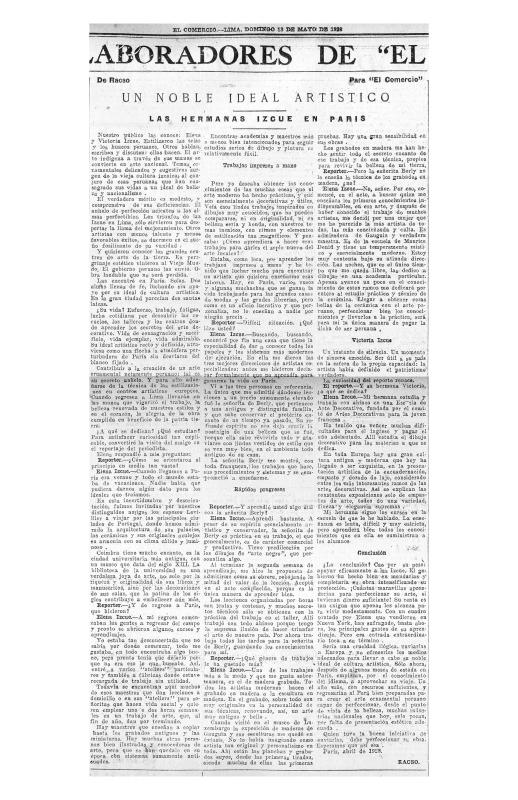This editorial note on the exhibition of Elena and Victoria Izcue in New York in 1935 appeared in the newspaper La Crónica in Lima, which included an article from the Correo, a publication by the Office of Intellectual Cooperation of the Pan-American Union in Washington D.C. In the 1920s a modern movement began to recuperate pre-Columbian aesthetic, indicating the archaeological development in Peru and the search of sources of national identity advocated by indigenism at that time. There is an interest by artists, researchers and intellectuals in using Pre-Columbian motifs and adapt them into the decorative and functional arts of the contemporary life. The artist Elena Izcue was instrumental in this movement. Not being followers of the indigenous group led by José Sabogal (1888–1956), they highlight their works with textile designs of applied arts and link their works with the fashion industry of Paris and New York. In 1927, thanks to a two-year pension granted to them by the Peruvian state, Elena and her sister Victoria would travel to the French capital to consolidate their artistic studies. In various workshops and factories abroad they achieved a successful career in the field of decorative arts, using printed fabrics with designs inspired by pre-Hispanic art. Their pieces were purchased by the prestigious House of Worth, fashion houses and private clients. In 1935 they travelled to New York and, thanks to the philanthropist Anne Morgan (1873–1952), presented the exhibition on Modern Art by Elena and Victoria Izcue, with textiles and pre-Inca ceramics in the galleries of the Fuller building. After the exhibition, they stayed in the city for a few months filling out orders for different firms. Towards the middle of 1935, the sculptor Malvina Hoffman and Anne Morgan of enormous influence with the highly affluent of New York and friends of the Izcues, proposed an exhibition on their work and art in that New York. Though at the time, Pre-Columbian interests in within the artistic circles was not yet very developed in North America, there were, however, important related events occurring in the metropolis of which among them was the exhibition on knitted Pre-Hispanic fabrics at the Metropolitan Museum (1930) and the exhibition on Pre-Columbian textiles of Central and South America at the Century Club (1931), in addition to the intense events undertaken by the American Indian Art Section and of Primitive Cultures at the Brooklyn Museum. Undoubtedly, a direct precedent was the exhibition by the designer Ruth Reeves at the Radio City Music Hall that same year in 1935. It consisted of traditional Guatemalan costumes and knitted fabrics with designs applied to interior decoration that were fashionable. Morgan deployed to contact all her contacts in New York to give a greater relevance to the exhibition of the Izcues; the events sponsored by the Brooklyn Museum, the American Museum of Natural History, the Carnegie Corporation, the Pan American Society and the Peruvian-American society, as well as to renowned artists, fashion industry figures and American archaeologists. Exhibited were the creations and works by Izcue sisters, some archeological pieces owned by them and by Rafael Larco Herrera and from museums and private collectors from New York. The exhibition was titled Exhibición de arte moderno por Elena y Victoria Izcue y textiles y ceramios pre-Inca and was presented for two weeks in the galleries of the Fuller Building on 57th Street. [Please refer to the ICAA digital archive for the following texts on the subject: “El arte peruano en la escuela” by Elena Izcue (doc. no. 1146099); “Un noble ideal artístico: las hermanas Izcue en París” by De Racso (doc. no. 1144316); “Una artista peruana en París” by Elvira García and García (doc. no. 1144288); “Un loable esfuerzo por el arte incaico: Prólogo” by Ventura García Calderón (doc. no. 1144261); “En el Museo Nacional: un ensayo de decoración estilo incaico”, by Alberto J. Martínez (doc. no. 1144009); “Las señoritas Izcue y el arte del antiguo Perú”, by Rafael Larco Herrera (doc. no. 1143993); and “Manuel Piqueras Cotolí” by Manuel Solari Swayne (doc. no. 1141324)].







